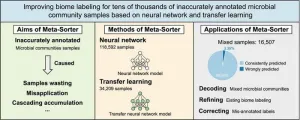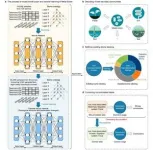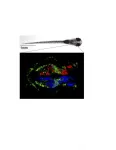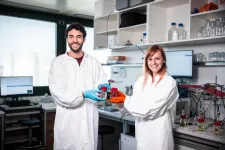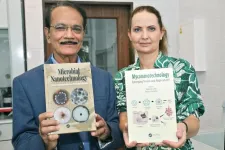Refining biome labeling for microbial community samples: AI approach unravels hidden
2023-09-08
(Press-News.org)
In a groundbreaking study published on July 26, 2023, in the journal Environmental Science and Ecotechnology, researchers from Huazhong University of Science and Technology have introduced "Meta-Sorter," an AI-based method that leverages neural networks and transfer learning to significantly improve biome labeling for thousands of microbiome samples in the MGnify database, especially those with incomplete information. The Meta-Sorter approach comprises two crucial steps. Firstly, a neural network model is meticulously constructed using 118,592 microbial samples from 134 biomes and their respective biome ontology, boasting an impressive average AUROC of 0.896. This model accurately classifies samples with detailed biome information, serving as a strong foundation for further analyses. Secondly, to address the challenge of newly introduced samples with different characteristics, researchers incorporated transfer learning with 34,209 newly added samples from 35 biomes, including eight novel ones. The transfer neural network model achieved an outstanding average AUROC of 0.989, successfully predicting biome information for newly introduced samples annotated as "Mixed biome." The results of Meta-Sorter are indeed impressive, achieving an overall accuracy rate of 96.7% in classifying samples among the 16,507 lacking detailed biome annotations. This groundbreaking breakthrough effectively resolves the issue of cascading errors and opens up exciting new possibilities for knowledge discovery across various scientific disciplines, particularly in environmental research. Moreover, Meta-Sorter's success extends to refining the biome annotation for under-annotated and mis-annotated samples. Its intelligent and automatic assignment of precise classifications to ambiguous samples provides valuable insights beyond the original literature, while the differentiation of samples into specific environmental categories enhances the reliability and validity of research conclusions.
Highlights
Neural network and transfer learning can improve the biome labeling of microbial communities.
Meta-Sorter can consistently classify up to 96.65% of the “Mixed biome” in the EBI-MGnify database.
Meta-Sorter prevents the cascading accumulation of inaccurate labels in environmental scientific research.
Meta-Sorter enables intelligent and automatic knowledge discovery from microbial communities.
With the ongoing development of standardized protocols for data submission and incorporation of additional meta-data information, Meta-Sorter is set to revolutionize the way researchers analyze and interpret microbial community samples. Ultimately, it will lead to more accurate and insightful discoveries in the realm of microbiome research and beyond.
###
References
DOI
10.1016/j.ese.2023.100304
Funding information
The National Natural Science Foundation of China (32071465, 31871334, and 31671374), The China Ministry of Science and Technology's National Key R&D Program (2018YFC0910502).
About Environmental Science and Ecotechnology
Environmental Science and Ecotechnology (ISSN 2666-4984) is an international, peer-reviewed, and open-access journal published by Elsevier. The journal publishes significant views and research across the full spectrum of ecology and environmental sciences, such as climate change, sustainability, biodiversity conservation, environment & health, green catalysis/processing for pollution control, and AI-driven environmental engineering. The latest impact factor of ESE is 12.6, according to the Journal Citation ReportTM 2022.
END
ELSE PRESS RELEASES FROM THIS DATE:
2023-09-08
BOSTON – Researchers who previously developed the first 3D human cell culture models of Alzheimer’s disease (AD) that displays two major hallmarks of the condition—the generation of amyloid beta deposits followed by tau tangles—have now used their model to investigate whether the exercise-induced muscle hormone irisin affects amyloid beta pathology.
As reported in the journal Neuron, the Massachusetts General Hospital (MGH)–led team has uncovered promising results suggesting that irisin-based ...
2023-09-08
About The Study: In this study of health care workers who received a COVID-19 vaccine, an influenza vaccine, or both, co-administration was not associated with substantially inferior immune response or to more frequent adverse events compared with COVID-19 vaccine administration alone, supporting the co-administration of these vaccines.
Authors: Gili Regev-Yochay, M.D., of the Sheba Medical Center in Ramat Gan, Israel, is the corresponding author.
To access the embargoed study: Visit our For The Media website at this link https://media.jamanetwork.com/
(doi:10.1001/jamanetworkopen.2023.32813)
Editor’s ...
2023-09-08
About The Study: The findings of this study suggest that childhood survivors of acute respiratory distress syndrome (ARDS) are at high risk of readmission in the first two months after discharge. Future studies should evaluate whether post-discharge interventions (e.g., telephonic contact, follow-up clinics, and home health care) may help reduce the readmission burden.
Authors: Garrett Keim, M.D., of Children’s Hospital of Philadelphia, is the corresponding author.
To access the embargoed study: Visit our For The Media website at this link https://media.jamanetwork.com/
(doi:10.1001/jamanetworkopen.2023.30774)
Editor’s ...
2023-09-08
The zebrafish brain, though simpler than its human counterpart, is a complex network of neurons that engage in a ceaseless dance of electrical activity. What if this neural ballet could reveal the secrets of how brains, including our own, control movement? A zebrafish study led by researchers at the Champalimaud Foundation offers a new lens through which to view the activity of neural populations, and to understand how the brain orchestrates motion.
Why we have a brain
“The brain’s primary function is movement”, explains Claudia Feierstein, lead author of the study ...
2023-09-08
“We engineered E. coli bacteria, the most widely studied microbe, to generate electricity,” says Professor Ardemis Boghossian at EPFL. “Though there are exotic microbes that naturally produce electricity, they can only do so in the presence of specific chemicals. E. coli can grow on a wide range of sources, which allowed us to produce electricity in a wide range of environments, including from waste water.”
In a paper published in the journal Joule, Boghossian’s team report a groundbreaking achievement in bioelectronics, advancing the capabilities of common E. coli bacteria to generate ...
2023-09-08
The ability to visualize faces, objects, landscapes, or even scenes from the past exists on a spectrum. While some can picture the layout of a city in minute detail and mentally walk through it, street by street, others have a perfectly blank internal cinema. In this case, we speak of aphantasia—the inability to voluntarily produce the visual mental image corresponding to an idea.
People whose aphantasia is congenital—i.e., not due to a stroke, brain injury, or psychiatric illness—become aware of their peculiarity reasonably ...
2023-09-08
As of today, climate models face the challenge of providing the high-resolution predictions - with quantified uncertainties - needed by a growing number of adaptation planners, from local decision-makers to the private sector, who require detailed assessments of the climate risks they may face locally.
This calls for a step change in the accuracy and usability of climate predictions that, according to the authors of the paper “Harnessing AI and computing to advance climate modelling and prediction”, can ...
2023-09-08
A paper published in the journal Monthly Notices of the Royal Astronomical Society hints at the existence of several black holes in the Hyades cluster — the closest open cluster to our solar system — which would make them the closest black holes to Earth ever detected. The study results from a collaboration between a group of scientists led by Stefano Torniamenti, from the University of Padua (Italy), with the significant participation of with Mark Gieles, ICREA professor at the Faculty of Physics, the ...
2023-09-08
This September 24–29, at the 10th Heidelberg Laureate Forum (HLF), 200 young researchers in mathematics and computer science will spend a week of scientific exchange with the recipients of the disciplines’ most prestigious prizes: the Abel Prize, ACM A.M. Turing Award, ACM Prize in Computing, Fields Medal, the Nevanlinna Prize as well as its continuation, the IMU Abacus Medal. Below are a few highlights of the upcoming program of the HLF as well as a breakdown of how to cover this unique event.
More ...
2023-09-08
Nanoparticles are tiny structures up to 100 nanometers in size. They are characterized by different physical and chemical properties and biological activity than their larger material counterparts. - When the starting material on a micro-scale with a specific surface area is broken down to nano size, i.e. into smaller particles, its surface area will increase many times. And it is the ratio of surface to volume that results in the unique properties of nanoparticles, explains Prof. Mahendra Rai from Sant Gadge Baba Amravati University in India.
Nanoparticles can be mainly ...
LAST 30 PRESS RELEASES:
[Press-News.org] Refining biome labeling for microbial community samples: AI approach unravels hidden
